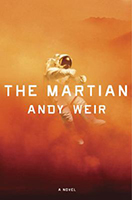 There’s a lot of talk about this book lately, since they just made it into what I’m told is a very good movie. I heard the scuttlebutt and watched the preview for the film, and when the protagonist/narrator said “I’m going to have to science the shit out of this,” I knew this was probably a story for me. I was lucky to score a copy of the audiobook from my county library, and really enjoyed listening to it over the past two weeks. So kudos to the narrator, R.C. Bray.
There’s a lot of talk about this book lately, since they just made it into what I’m told is a very good movie. I heard the scuttlebutt and watched the preview for the film, and when the protagonist/narrator said “I’m going to have to science the shit out of this,” I knew this was probably a story for me. I was lucky to score a copy of the audiobook from my county library, and really enjoyed listening to it over the past two weeks. So kudos to the narrator, R.C. Bray.
There’s a lot to love about this book: the premise that NASA (as opposed to private companies) are sending astronauts to Mars, the profanity and humor of the protagonist, Mark Watney, and the paean to science and engineering throughout his numerous adventures. It is a secular book with no aliens, monsters or gods. Actually, “gods” (plural) do get mentioned, as the NASA head of Mars missions is a Hindu, and apparently believes in (his words) “a bunch of them.” But nowhere else is anything supernatural invoked. One of the things I love about the story is that it features a depiction of straight-up physical reality, fixing tangible problems like “not enough water” and “spacesuit leaking air” through clever applications of chemistry and physics. This makes it feel authentic – so much so that apparently there’s a significant number of people who think it’s a true story! I love the fact that it is both possible and insightful to plot Watney’s path over the Martian surface on a dynamic Google Mars map!
Watney has to MacGyver his way out of dozens of jams using only his brain and the tools on hand. Doing this time and again, he manages to survive a year and a half alone on Mars. It’s a beautiful tale because it emphasizes the bounty our planet provides to us free of charge and free of effort, and reminds us to be thankful for that. Watney has to calculate how many potatoes he needs to grow in order to not starve, and therefore how much water he needs, and how much viable soil he needs, and then he makes more water (from jet fuel!) and more soil (from poop mixed with regolith). Later in the story, at a different location, more rocket fuel is needed, and so the water from Watney’s pee is put under electrolysis to make hydrogen, which a machine can combine with CO2 from the Martian atmosphere to make rocket fuel.
I guess Watney’s domain (the “Hab” and two rovers, plus his EVA suits) would not quite officially meet the criteria to count as a closed system, but it comes close. The same can be said for the ship that transports the astronauts to and from Mars, the Hermes. There, in one minor plot twist, it’s revealed that NASA has calculated how many calories are on board the ship to sustain a person, and included in the count are the calories in the bodies of all of her crewmates. I find it refreshing to read this sort of straight-forward recognition of the fundamental nature of our bodies – they are made of atoms, bonded to other atoms, and if we understand that, we can do unexpected things with them. It’s thinking outside the box, for sure – and Weir, like MacGyver, excels at pushing the envelope in surprising directions. This “closed system” perspective is illuminating in another regard, I think – it reminds us that Earth itself is just a bigger version of the same thing – While it may be harder for us to see the edges of the big planet-sized “Hab” we live on, it possesses discrete boundaries just the same. There is a finite amount of matter aboard. If Watney’s system for scrubbing CO2 from the Hab air breaks down, he’s in trouble. If our planet’s capacity for scrubbing CO2 from our atmosphere can’t match anthropogenic inputs, then we’re in trouble. There are, in short, environmental lessons to be learned from the system perspective, and Watney’s fictional case is a fun, exciting place to start learning.
A top notch adventure, in short. I really enjoyed it, and to me, it lived up to the hype. Check it out.
